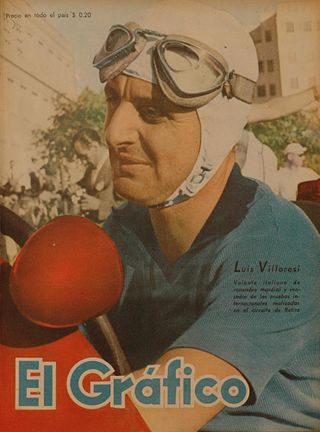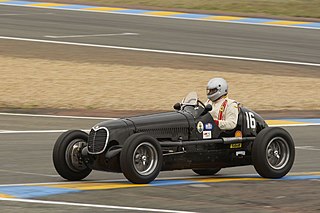The Alta Car and Engineering Company was a British sports and racing car manufacturer, commonly known simply as Alta. Their cars contested five FIA World Championship races between 1950 and 1952, as well as Grand Prix events prior to this. They also supplied engines to a small number of other constructors, most notably the Connaught and HWM teams.

The 1952 French Grand Prix was a Formula Two race held on 6 July 1952 at Rouen-Les-Essarts. It was race 4 of 8 in the 1952 World Championship of Drivers, in which each Grand Prix was run to Formula Two rules rather than the Formula One regulations normally used. Unusually this race was run over a duration of 3 hours, rather than a fixed distance.

The 1953 Belgian Grand Prix was a Formula Two race held on 21 June 1953 at Circuit de Spa-Francorchamps. It was race 4 of 9 in the 1953 World Championship of Drivers, which was run to Formula Two rules in 1952 and 1953, rather than the Formula One regulations normally used. The 36-lap race was won by Ferrari driver Alberto Ascari after he started from second position. His teammate Luigi Villoresi finished second and Maserati driver Onofre Marimón came in third.
The 1951 Formula One season was the fifth season of FIA Formula One motor racing. It featured the 1951 World Championship of Drivers, which commenced on 27 May 1951 and ended on 28 October after eight races. The season also included 14 races open to Formula One cars but did not count towards the championship standings.
The 1950 Formula One season was the fourth season of the FIA's Formula One motor racing. It featured the inaugural FIA World Championship of Drivers, as well as several non-championship races. The championship, which commenced on 13 May and ended on 3 September, consisted of six Grand Prix races, each held in Europe and open to Formula One cars, plus the Indianapolis 500, which was run to AAA National Championship regulations. Giuseppe Farina won the championship from Juan Manuel Fangio and Luigi Fagioli.

Luigi Villoresi was an Italian Grand Prix motor racing driver who started racing in Formula One at the time of its inception.

Frederick Roberts Gerard was a racing driver and businessman from England. He participated in numerous top-level motor racing events on either side of World War II, including eight World Championship Formula One Grands Prix, scoring no championship points.

English Racing Automobiles (ERA) was a British racing car manufacturer active from 1933 to 1954.

The Maserati 6CM is an Italian single-seater racing car, made by Maserati of Modena from 1936 to 1940 for the Voiturette racing class. Twenty-seven were built on the Maserati 4CM frame, with front suspension as on the Maserati V8RI, and had a successful racing career from 1936 to 1939. The 6CM was introduced to the world at the 1936 Milan Motor Show. Maserati spent much of its early years manufacturing cars for privateers in the racing field. The Maserati 6CM is no exception.

The 1935 Grand Prix season was the second year of the new 750 kg Formula. The success of the previous year encouraged the AIACR to reinitiate the European Championship. It was composed of the seven national Grands Prix and was won by Rudolf Caracciola, driving for the Mercedes-Benz team. The team dominated the season winning five of those Grand Épreuves, as well as four of the other major races of the season. However, in one of the great motor-races in sporting history, Tazio Nuvolari in a Scuderia Ferrari Alfa Romeo beat the combined numbers of the German teams in their home Grand Prix. The season also saw the arrival on the international stage of the bright young talent Bernd Rosemeyer in the Auto Union team.

The Alfa Romeo 158/159, also known as the Alfetta, is a Grand Prix racing car produced by Italian manufacturer Alfa Romeo. It is one of the most successful racing cars ever; the 158 and its derivative, the 159, took 47 wins from 54 Grands Prix entered. It was originally developed for the pre-World War II voiturette formula (1937) and has a 1.5-litre straight-8 supercharged engine. Following World War II, the car was eligible for the new Formula One introduced in 1947. In the hands of drivers such as Nino Farina, Juan Manuel Fangio and Luigi Fagioli, it dominated the first two seasons of the World Championship of Drivers.

The Alfa Romeo Tipo 308 or 8C-308 is a Grand Prix racing car made for the 3 litre class in 1938. Only four cars were produced, actually modified from Tipo C with the engine mounted lower into the chassis and a slimmer body. The chassis was derived from the Tipo C and the engine from the 8C 2900. The 308 was engineered by Gioacchino Colombo under the control of Enzo Ferrari who was then in charge of Alfa's racing team, Alfa Corse. The car debuted at the Pau Grand Prix in 1938, where two cars were entered to race, one for Tazio Nuvolari and the other for Luigi Villoresi. Both drivers had to withdraw from competition, however Nuvolari had by then set a lap record. The next race was the Tripoli Grand Prix. The new 312 and 316 were entered, but they had engine trouble during practice and Clemente Biondetti took the start at the wheel of the 308 held in reserve. He failed to finish, while Hermann Lang, driving a Mercedes-Benz W154, was the winner. In this race, Eugenio Siena, driving a 312, was killed after hitting a wall.
The 1934 Grand Prix season saw the advent of the new 750 kg Formula. In an effort to curb the danger of rising speeds, the AIACR imposed this upper weight limit that effectively outlawed the large capacity engines. The incumbent manufacturers Alfa Romeo, Maserati and Bugatti had been preparing their new models with varying success – the best of which was the Alfa Romeo Tipo B. However, it was the state-sponsored arrival of the two German teams, Mercedes-Benz and Auto Union, and their innovative and progressive cars that ignited a new, exciting era of motor racing.
Enrico Platé was a motor racing driver and team manager. Although born in Italy, Platé raced, and latterly ran his racing team Scuderia Enrico Platé, under Swiss nationality. He began his career as a mechanic, but swiftly took to racing cars in addition to repairing them. His best result as a driver was fourth place in the 1938 Modena Autodrome. Although he did not achieve any notable success in the pre-World War II voiturette class, Enrico Platé became a significant and influential figure in post-war grand prix and early Formula One racing as a team owner. During his brief career in this role, Platé ran Maseratis for notable drivers such as Prince Bira, Harry Schell and fellow Swiss Toulo de Graffenried.

The Royal Automobile Club International Grand Prix was a motor race held on 2 October 1948, at Silverstone Airfield, Northamptonshire, UK. It is commonly cited as the first British Grand Prix of the modern era.
Scuderia Milano was an Italian Formula One motor racing team founded in Milan by Arialdo and Emilio Ruggeri, two brothers who had raced Maseratis in the early post-war period. The team scored two World Championship points on its debut, when Felice Bonetto finished fifth at the 1950 Swiss Grand Prix.
Throughout its history, the Italian auto manufacturer Maserati has participated in various forms of motorsport including Formula One, sportscar racing and touring car racing, both as a works team and through private entrants. Maserati currently competes in Formula E in partnership with the Monaco Sports Group (MSG) as Maserati MSG Racing.

The Circuito di Ospedaletti commonly known as the Ospedaletti Circuit was a motor racing road course in the north-western coastal town of Ospedaletti, active from 1947 to 1972.

The 1948 San Remo Grand Prix was a non-Championship Voiturette motor race held on 27 June 1948 at the Autodromo di Ospedaletti, in Sanremo, Liguria, Italy. It was the 8th race of the 1948 Grand Prix season. The race, contested over 85 laps, was won by Alberto Ascari in a Maserati 4CLT/48, starting from pole position. Luigi Villoresi finished second also in a Maserati 4CLT/48 and Clemar Bucci third, driving a Maserati 4CL 1502.

The Ferrari 166 FL was a single-seat open-wheel race car, designed, developed and built by Italian manufacturer and team, Scuderia Ferrari, 1949 to 1952. Only three cars were produced. The designation 166 refers to the (rounded) displacement of a single cylinder, which corresponded to the nomenclature of the company at the time. The abbreviation FL stands for Formula Libre, which is the type of category and racing series that the car competed in. Since the car was mainly developed for racing in South America, it was also known as the 166 C America.


















